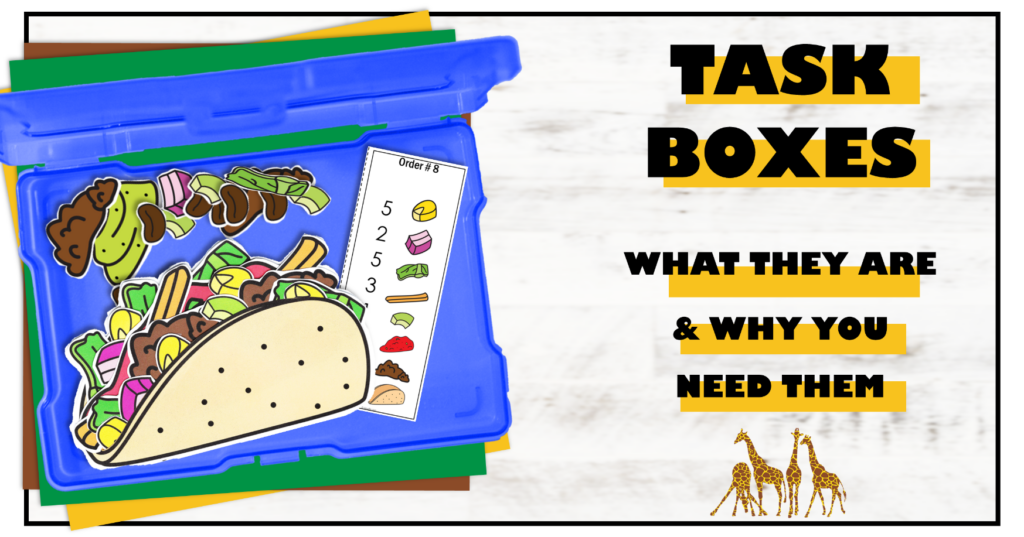
Task boxes are a LIFE SAVER in an elementary classroom. Use them as fast finishers, independent work, for sub tubs, or when you just need a few minutes to grab a drink and grade an assignment.
Task boxes are small, portable containers that house specific, hands-on activities designed to reinforce skills or concepts. Each task box contains all the materials needed to complete a single task or activity, making them a self-contained learning tool. These tasks can range from academic skills like math and reading to life skills, fine motor skills, and more.
Task boxes are designed for independent use, allowing students to work at their own pace. This independence fosters self-reliance and problem-solving skills, as students learn to follow instructions and complete tasks without constant teacher intervention.
Tip: Rotate boxes regularly to maintain student interest and provide a range of skills practice.
Implementing task boxes can significantly improve classroom management by providing structured, purposeful activities that keep students engaged. When students are occupied with them, it reduces idle time and minimizes disruptions, creating a more orderly learning environment.
Tip: Use the boxes during transition periods or as part of a daily routine to maintain a calm and focused classroom atmosphere.
Task boxes are highly adaptable, making them ideal for differentiated instruction. You can create or modify task boxes to match the varying skill levels and needs of your students, ensuring that each child is appropriately challenged and supported.
A task box offers hands-on learning opportunities that are both engaging and interactive. These tactile experiences are especially beneficial for young learners and students with special needs, as they can explore concepts through manipulation and play.
Once created, task boxes are easy to store, organize, and prepare for daily use. Each box is self-contained and ready to go, eliminating the need for last-minute preparation and reducing teacher workload. They can be stored on shelves, in bins, or in a dedicated task box station for easy access.
Tip: Label each box clearly with the skill it addresses and a picture of the activity to help students choose tasks independently.

Task boxes provide consistent, targeted practice that helps reinforce specific skills. Whether you’re focusing on academic skills like counting and letter recognition or functional skills like tying shoelaces, they offer repetitive practice that strengthens student proficiency.
Task boxes can serve as informal assessment tools, allowing you to observe and document student progress on specific skills. This ongoing assessment helps you identify areas where students may need additional support or challenge.
Tip: Keep a log or checklist to track student performance and progress on task box activities, making it easier to adjust instruction as needed.
Task boxes contribute to a positive learning environment by offering students successful and manageable learning experiences. Completing a task independently can boost a student’s confidence and motivation, leading to a more positive attitude toward learning.
A task box is a valuable tool for inclusive education, allowing all students, including those with special needs, to participate in meaningful and productive activities. They can be adapted to various abilities, making them an inclusive resource that promotes equity and access to learning.
Tip: Collaborate with staff to design boxes that meet the needs of all students, ensuring that activities are accessible and beneficial.
Task boxes can also be sent home as part of homework or skill reinforcement programs, encouraging parent and caregiver involvement in their child’s learning. These take-home tasks provide a structured way for families to support their child’s education outside the classroom.
Tip: Include simple instructions and a feedback form for parents to provide insights into their child’s performance with the task box at home.
Task boxes are a versatile and effective tool that can transform classroom management, enhance learning, and support differentiated instruction. By providing hands-on, engaging activities that promote independence and skill reinforcement, task boxes make teaching more manageable and learning more enjoyable. Whether you’re looking to streamline your preparation, support diverse learning needs, or foster a positive classroom environment, task boxes are a must-have resource for every elementary school teacher.
Integrate task boxes into your teaching toolkit today and experience the benefits of organized, effective, and engaging learning activities that simplify your teaching life and enhance your students’ educational journey.